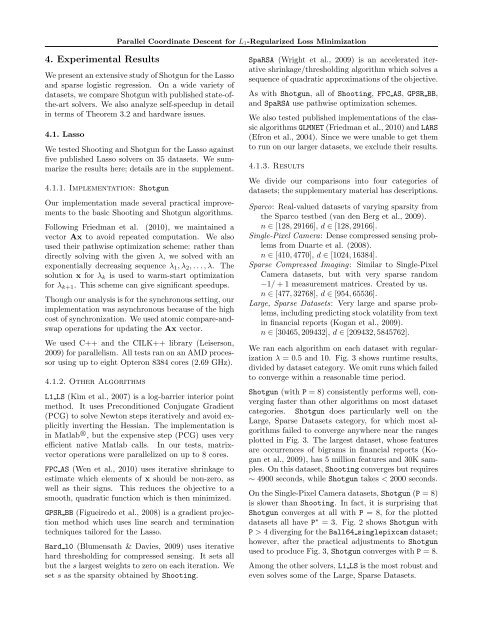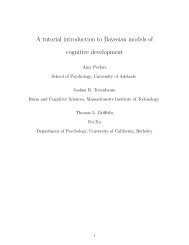Parallel Coordinate Descent for L1-Regularized Loss Minimization
Parallel Coordinate Descent for L1-Regularized Loss Minimization
Parallel Coordinate Descent for L1-Regularized Loss Minimization
Create successful ePaper yourself
Turn your PDF publications into a flip-book with our unique Google optimized e-Paper software.
<strong>Parallel</strong> <strong>Coordinate</strong> <strong>Descent</strong> <strong>for</strong> L 1-<strong>Regularized</strong> <strong>Loss</strong> <strong>Minimization</strong><br />
4. Experimental Results<br />
We present an extensive study of Shotgun <strong>for</strong> the Lasso<br />
and sparse logistic regression. On a wide variety of<br />
datasets, we compare Shotgun with published state-ofthe-art<br />
solvers. We also analyze self-speedup in detail<br />
in terms of Theorem 3.2 and hardware issues.<br />
4.1. Lasso<br />
We tested Shooting and Shotgun <strong>for</strong> the Lasso against<br />
five published Lasso solvers on 35 datasets. We summarize<br />
the results here; details are in the supplement.<br />
4.1.1. Implementation: Shotgun<br />
Our implementation made several practical improvements<br />
to the basic Shooting and Shotgun algorithms.<br />
Following Friedman et al. (2010), we maintained a<br />
vector Ax to avoid repeated computation. We also<br />
used their pathwise optimization scheme: rather than<br />
directly solving with the given λ, we solved with an<br />
exponentially decreasing sequence λ 1 , λ 2 , . . . , λ. The<br />
solution x <strong>for</strong> λ k is used to warm-start optimization<br />
<strong>for</strong> λ k+1 . This scheme can give significant speedups.<br />
Though our analysis is <strong>for</strong> the synchronous setting, our<br />
implementation was asynchronous because of the high<br />
cost of synchronization. We used atomic compare-andswap<br />
operations <strong>for</strong> updating the Ax vector.<br />
We used C++ and the CILK++ library (Leiserson,<br />
2009) <strong>for</strong> parallelism. All tests ran on an AMD processor<br />
using up to eight Opteron 8384 cores (2.69 GHz).<br />
4.1.2. Other Algorithms<br />
<strong>L1</strong> LS (Kim et al., 2007) is a log-barrier interior point<br />
method. It uses Preconditioned Conjugate Gradient<br />
(PCG) to solve Newton steps iteratively and avoid explicitly<br />
inverting the Hessian. The implementation is<br />
in Matlab R○ , but the expensive step (PCG) uses very<br />
efficient native Matlab calls. In our tests, matrixvector<br />
operations were parallelized on up to 8 cores.<br />
FPC AS (Wen et al., 2010) uses iterative shrinkage to<br />
estimate which elements of x should be non-zero, as<br />
well as their signs. This reduces the objective to a<br />
smooth, quadratic function which is then minimized.<br />
GPSR BB (Figueiredo et al., 2008) is a gradient projection<br />
method which uses line search and termination<br />
techniques tailored <strong>for</strong> the Lasso.<br />
Hard l0 (Blumensath & Davies, 2009) uses iterative<br />
hard thresholding <strong>for</strong> compressed sensing. It sets all<br />
but the s largest weights to zero on each iteration. We<br />
set s as the sparsity obtained by Shooting.<br />
SpaRSA (Wright et al., 2009) is an accelerated iterative<br />
shrinkage/thresholding algorithm which solves a<br />
sequence of quadratic approximations of the objective.<br />
As with Shotgun, all of Shooting, FPC AS, GPSR BB,<br />
and SpaRSA use pathwise optimization schemes.<br />
We also tested published implementations of the classic<br />
algorithms GLMNET (Friedman et al., 2010) and LARS<br />
(Efron et al., 2004). Since we were unable to get them<br />
to run on our larger datasets, we exclude their results.<br />
4.1.3. Results<br />
We divide our comparisons into four categories of<br />
datasets; the supplementary material has descriptions.<br />
Sparco: Real-valued datasets of varying sparsity from<br />
the Sparco testbed (van den Berg et al., 2009).<br />
n ∈ [128, 29166], d ∈ [128, 29166].<br />
Single-Pixel Camera: Dense compressed sensing problems<br />
from Duarte et al. (2008).<br />
n ∈ [410, 4770], d ∈ [1024, 16384].<br />
Sparse Compressed Imaging: Similar to Single-Pixel<br />
Camera datasets, but with very sparse random<br />
−1/ + 1 measurement matrices. Created by us.<br />
n ∈ [477, 32768], d ∈ [954, 65536].<br />
Large, Sparse Datasets: Very large and sparse problems,<br />
including predicting stock volatility from text<br />
in financial reports (Kogan et al., 2009).<br />
n ∈ [30465, 209432], d ∈ [209432, 5845762].<br />
We ran each algorithm on each dataset with regularization<br />
λ = 0.5 and 10. Fig. 3 shows runtime results,<br />
divided by dataset category. We omit runs which failed<br />
to converge within a reasonable time period.<br />
Shotgun (with P = 8) consistently per<strong>for</strong>ms well, converging<br />
faster than other algorithms on most dataset<br />
categories. Shotgun does particularly well on the<br />
Large, Sparse Datasets category, <strong>for</strong> which most algorithms<br />
failed to converge anywhere near the ranges<br />
plotted in Fig. 3. The largest dataset, whose features<br />
are occurrences of bigrams in financial reports (Kogan<br />
et al., 2009), has 5 million features and 30K samples.<br />
On this dataset, Shooting converges but requires<br />
∼ 4900 seconds, while Shotgun takes < 2000 seconds.<br />
On the Single-Pixel Camera datasets, Shotgun (P = 8)<br />
is slower than Shooting. In fact, it is surprising that<br />
Shotgun converges at all with P = 8, <strong>for</strong> the plotted<br />
datasets all have P ∗ = 3. Fig. 2 shows Shotgun with<br />
P > 4 diverging <strong>for</strong> the Ball64 singlepixcam dataset;<br />
however, after the practical adjustments to Shotgun<br />
used to produce Fig. 3, Shotgun converges with P = 8.<br />
Among the other solvers, <strong>L1</strong> LS is the most robust and<br />
even solves some of the Large, Sparse Datasets.



